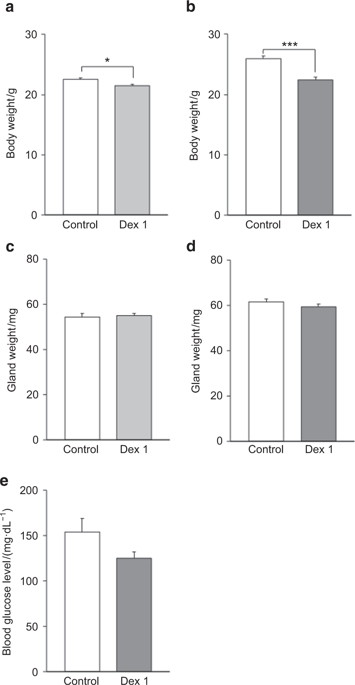International Journal of Oral Science ( IF 10.8 ) Pub Date : 2019-01-03 , DOI: 10.1038/s41368-018-0031-0 Yuichiro Kusuda , Yusuke Kondo , Yuta Miyagi , Takashi Munemasa , Yusuke Hori , Fumiko Aonuma , Shintaro Tsuka , Taro Mukaibo , Chihiro Masaki , Ryuji Hosokawa

|
Corticosteroids are used in the treatment of many diseases; however, they also induce various side effects. Dexamethasone is one of the most potent corticosteroids, and it has been reported to induce the side effect of impaired salivary gland function. This study aimed to evaluate the effects of dexamethasone on mouse submandibular gland function to gain insight into the mechanism of dexamethasone-induced salivary hypofunction. The muscarinic agonist carbachol (CCh) induced salivary secretion and was not affected by short-term dexamethasone treatment but was decreased following long-term dexamethasone administration. The expression levels of the membrane proteins Na+-K+-2Cl− cotransporter, transmembrane member 16A, and aquaporin 5 were comparable between the control and long-term dexamethasone treatment groups. The CCh-induced increase in calcium concentration was significantly lower in the presence of extracellular Ca2+ in the long-term dexamethasone treatment group compared to that in the control group. Furthermore, CCh-induced salivation in the absence of extracellular Ca2+ and Ca2+ ionophore A23187-induced salivation was comparable between the control and long-term dexamethasone treatment groups. Moreover, salivation induced by the Ca2+-ATPase inhibitor thapsigargin was diminished in the long-term dexamethasone treatment group. In summary, these results demonstrate that short-term dexamethasone treatment did not impair salivary gland function, whereas long-term dexamethasone treatment diminished store-operated Ca2+ entry, resulting in hyposalivation in mouse submandibular glands.
中文翻译:

长期地塞米松治疗可减少唾液腺泡细胞中的存储操作性Ca 2+进入
皮质类固醇用于多种疾病的治疗。但是,它们也会引起各种副作用。地塞米松是最有效的皮质类固醇之一,据报道可诱导唾液腺功能受损。这项研究旨在评估地塞米松对小鼠下颌下腺功能的影响,以深入了解地塞米松诱导的唾液功能低下的机制。毒蕈碱激动剂卡巴胆碱(CCh)诱导唾液分泌,不受短期地塞米松治疗的影响,但在长期给予地塞米松后减少。膜蛋白的Na的表达水平+ -K + -2Cl -在对照组和长期地塞米松治疗组之间,共转运蛋白,跨膜成员16A和水通道蛋白5相当。与对照组相比,长期地塞米松治疗组在细胞外Ca 2+存在下,CCh诱导的钙浓度增加明显更低。此外,在不存在细胞外Ca 2+和Ca 2+离子载体A23187诱导的唾液的情况下,CCh诱导的唾液在对照组和长期地塞米松治疗组之间具有可比性。此外,Ca 2+引起的流涎在长期地塞米松治疗组中,-ATPase抑制剂thapsigargin减少。总而言之,这些结果表明,短期地塞米松治疗不会损害唾液腺功能,而长期地塞米松治疗则减少了存储操纵的Ca 2+进入,从而导致小鼠下颌腺的唾液分泌不足。











































 京公网安备 11010802027423号
京公网安备 11010802027423号